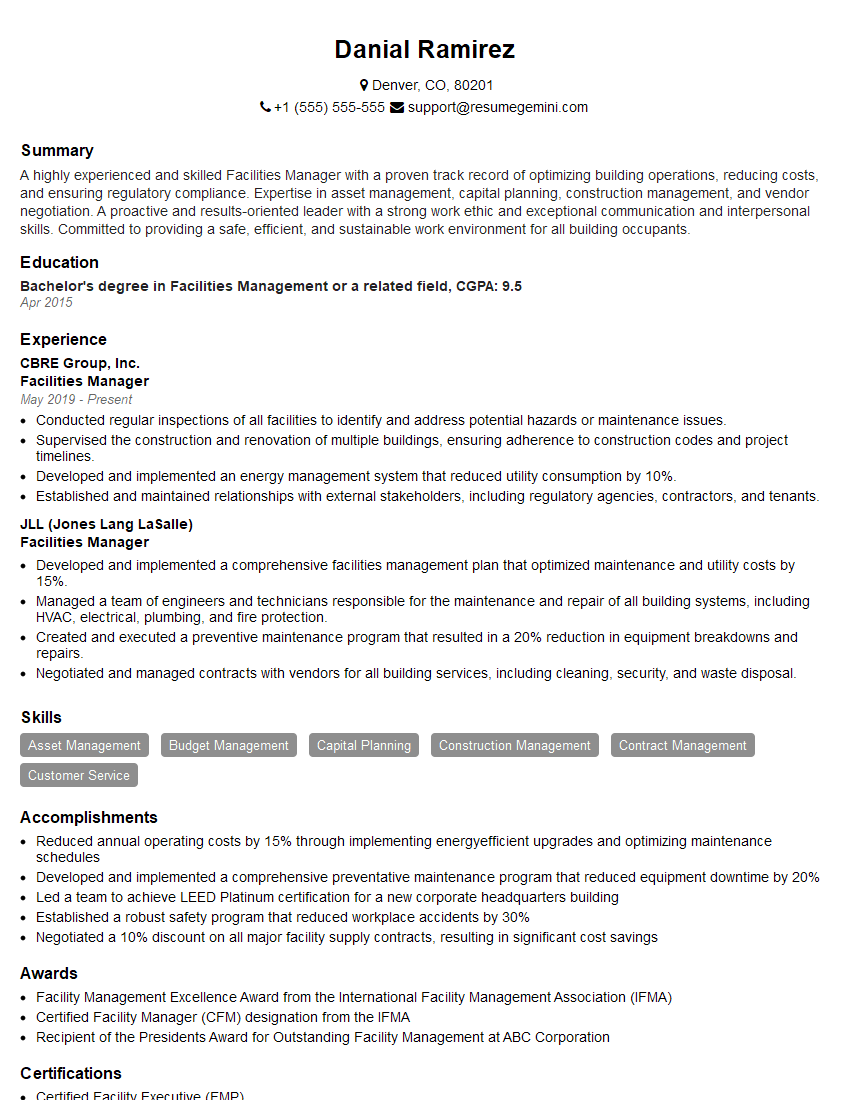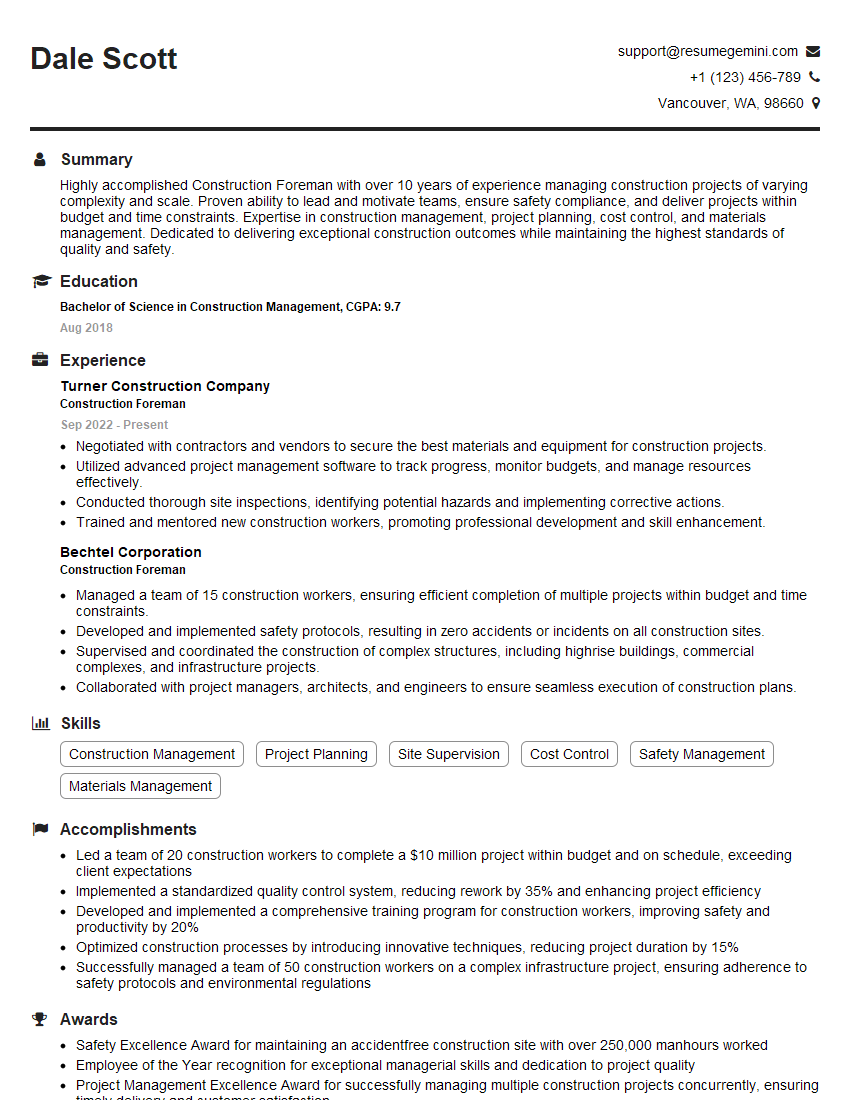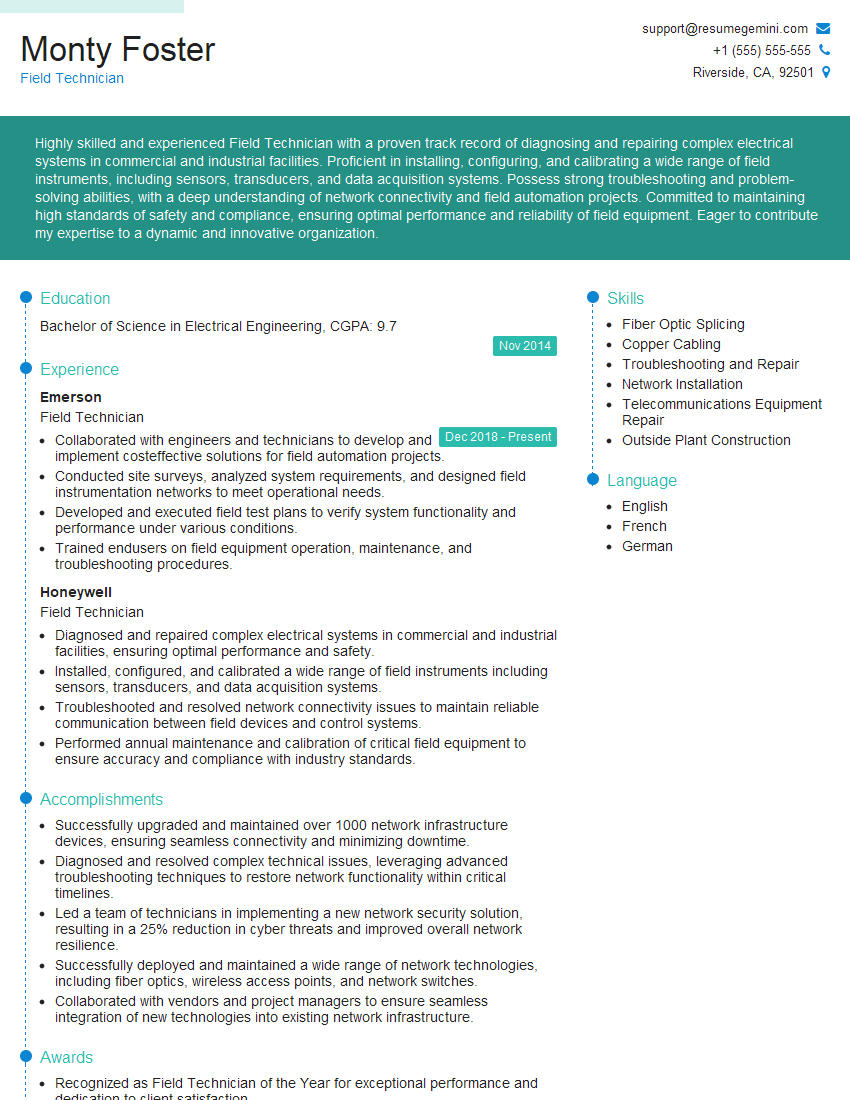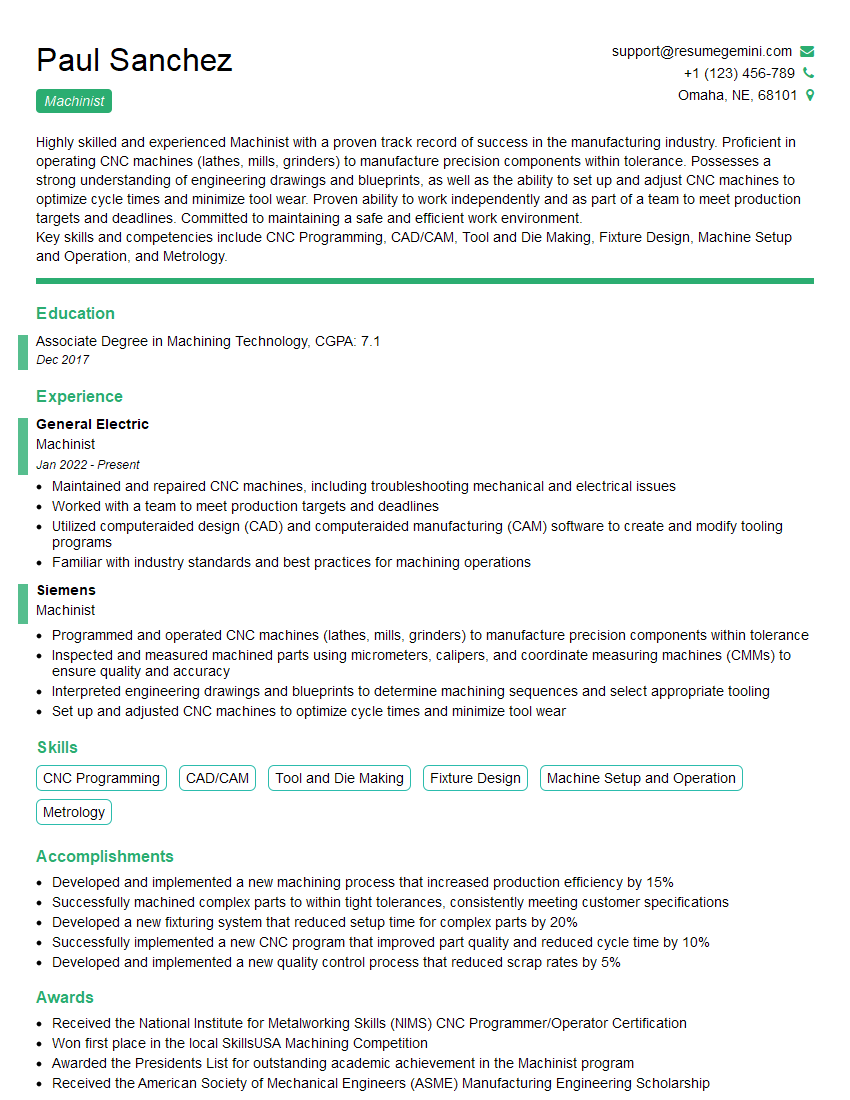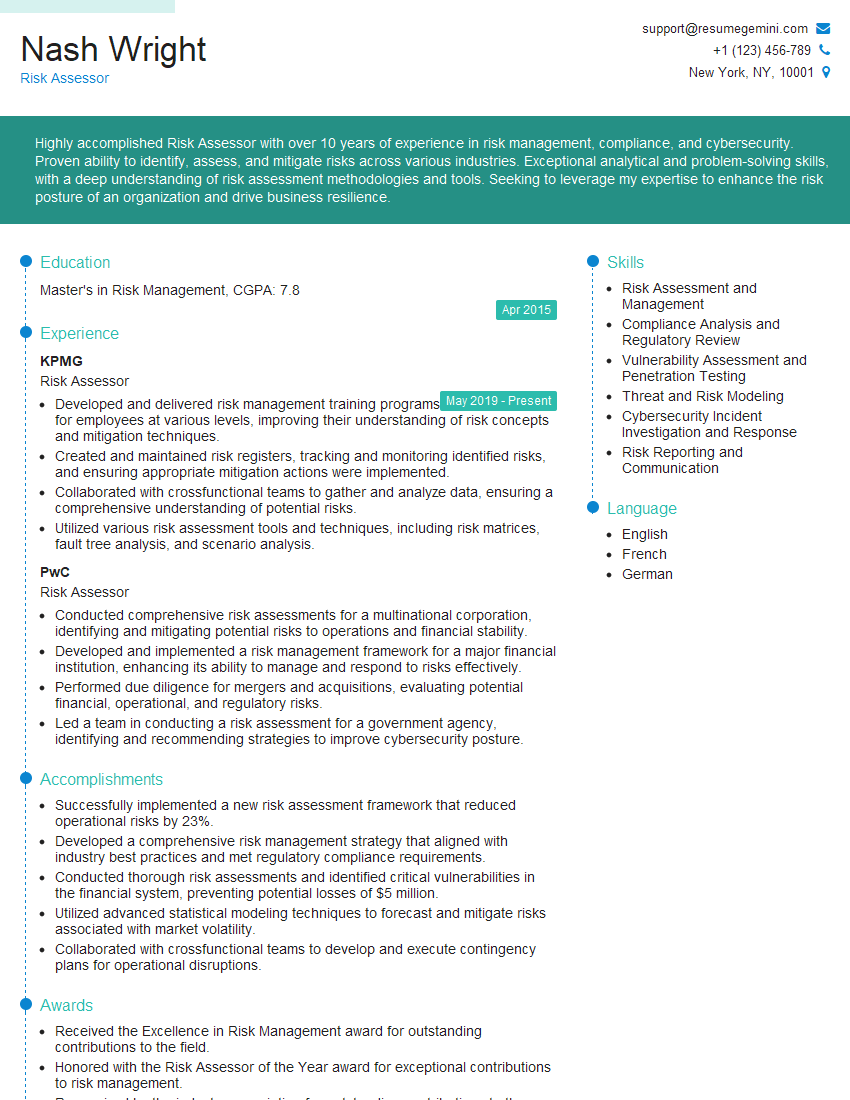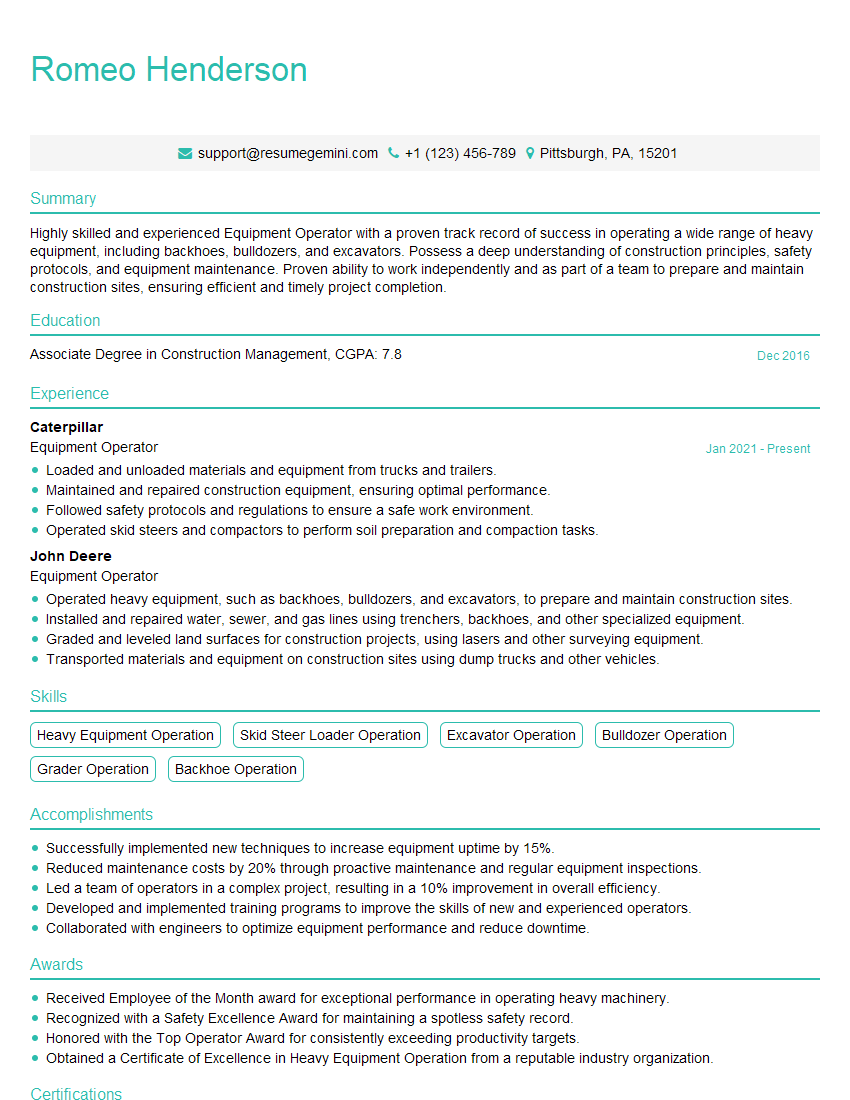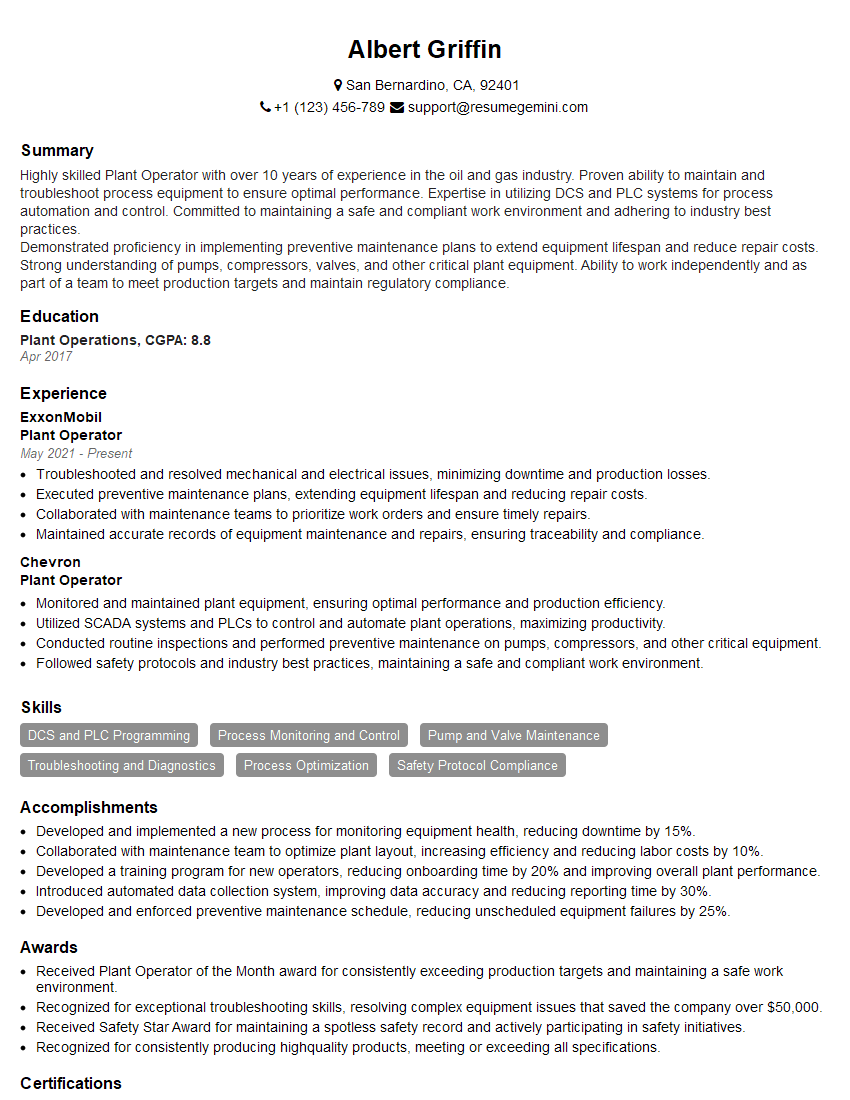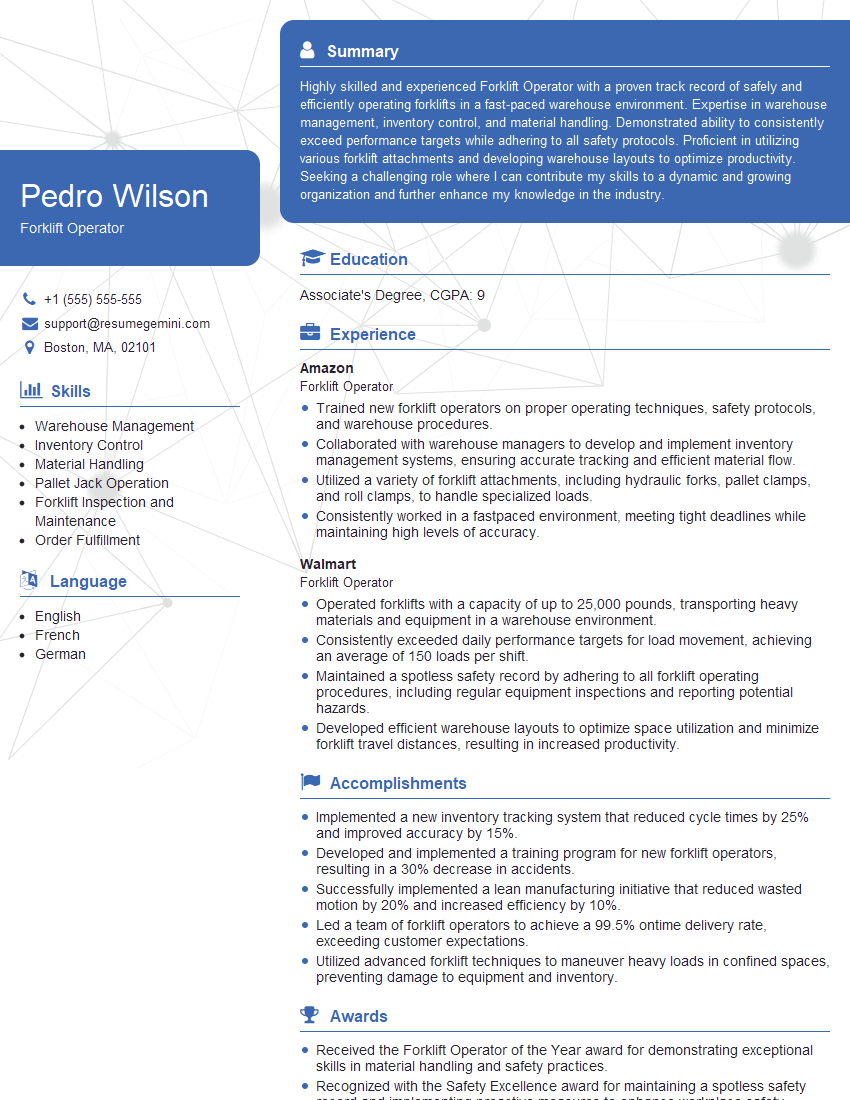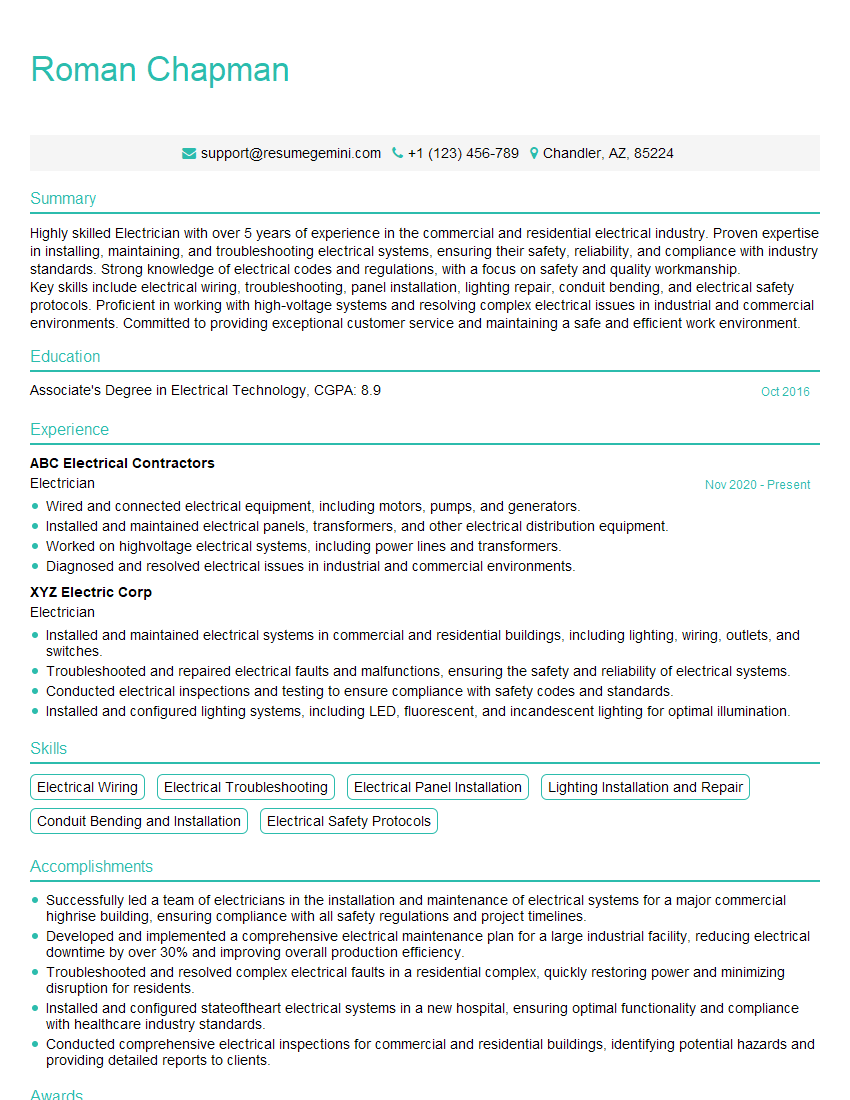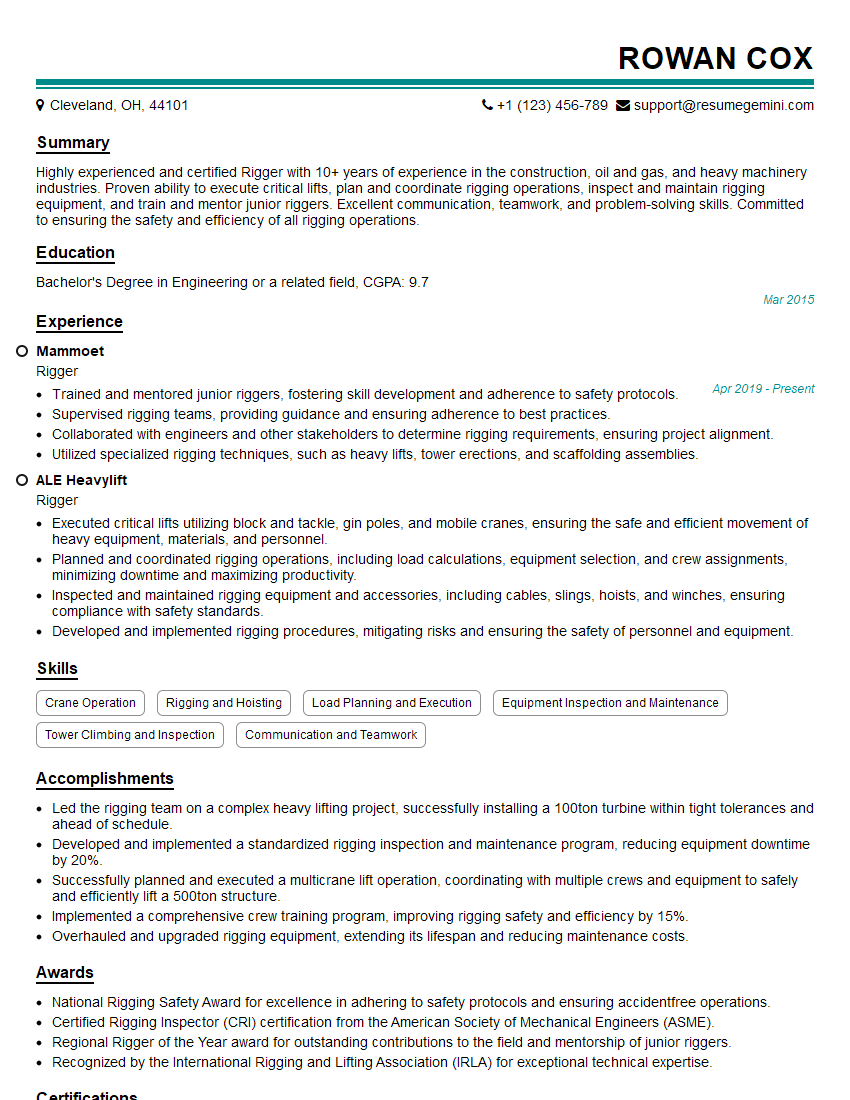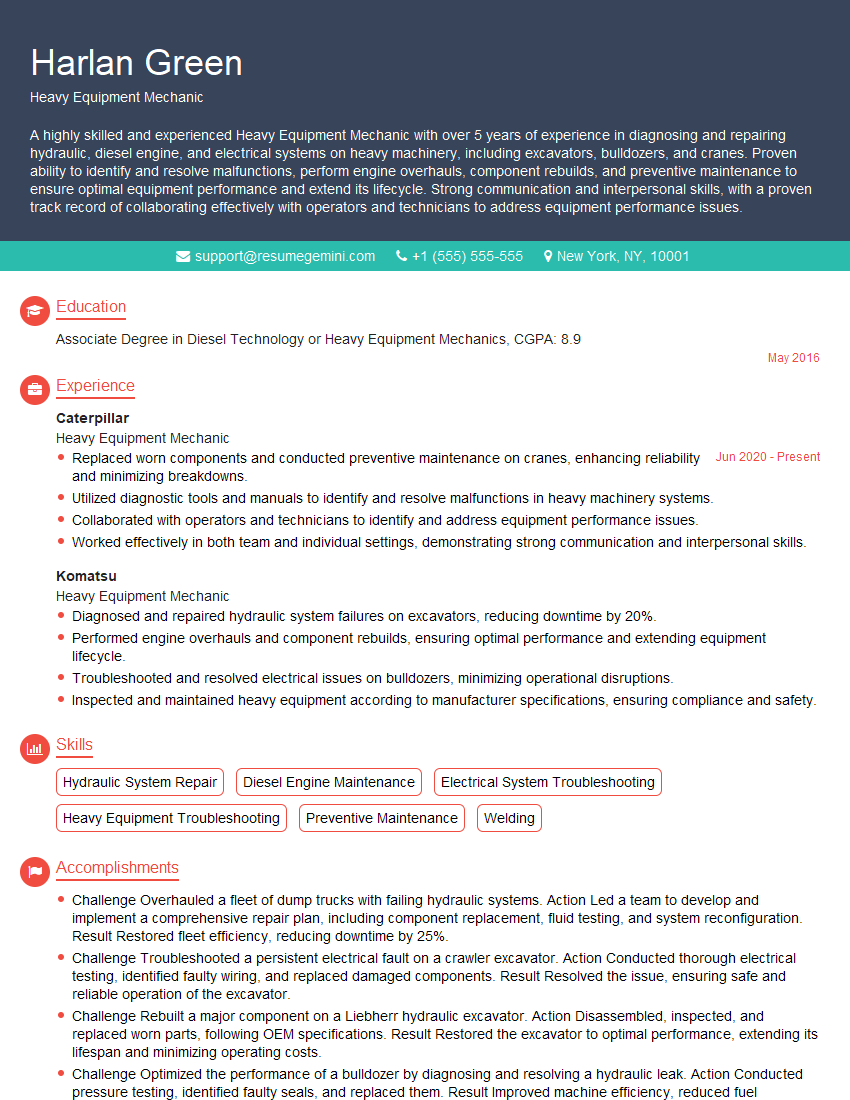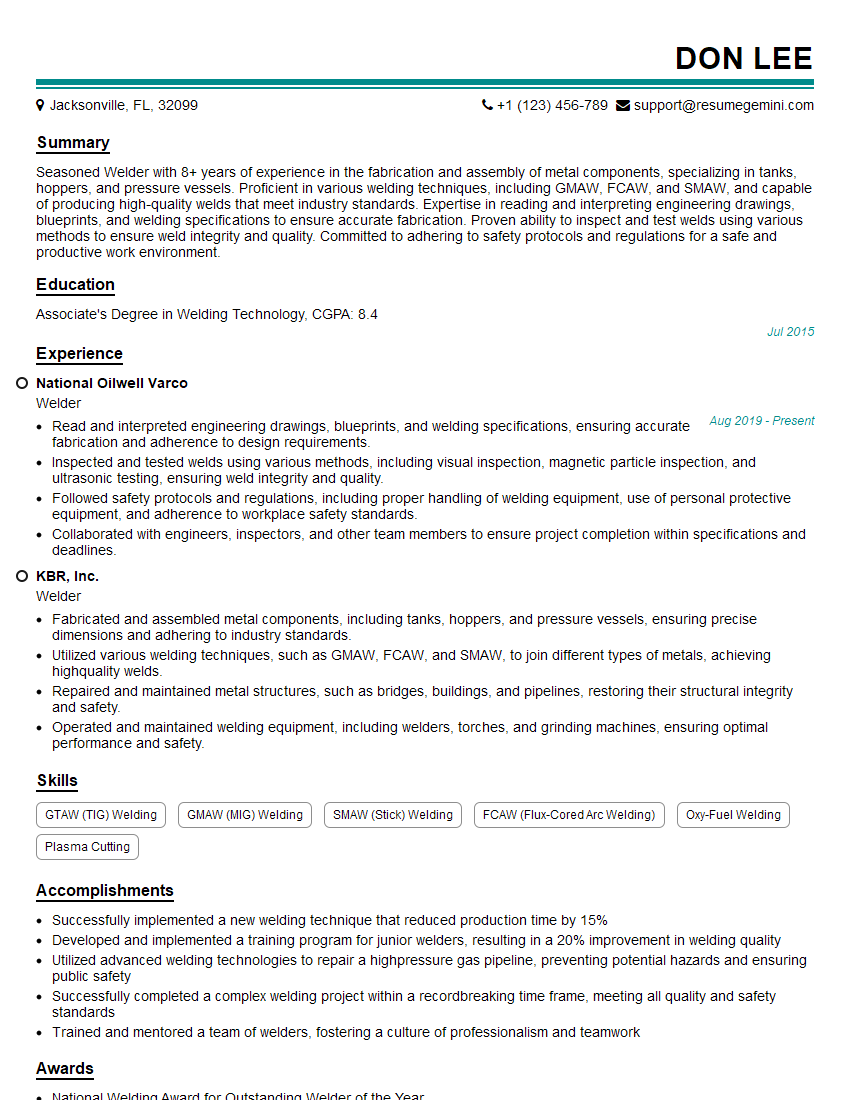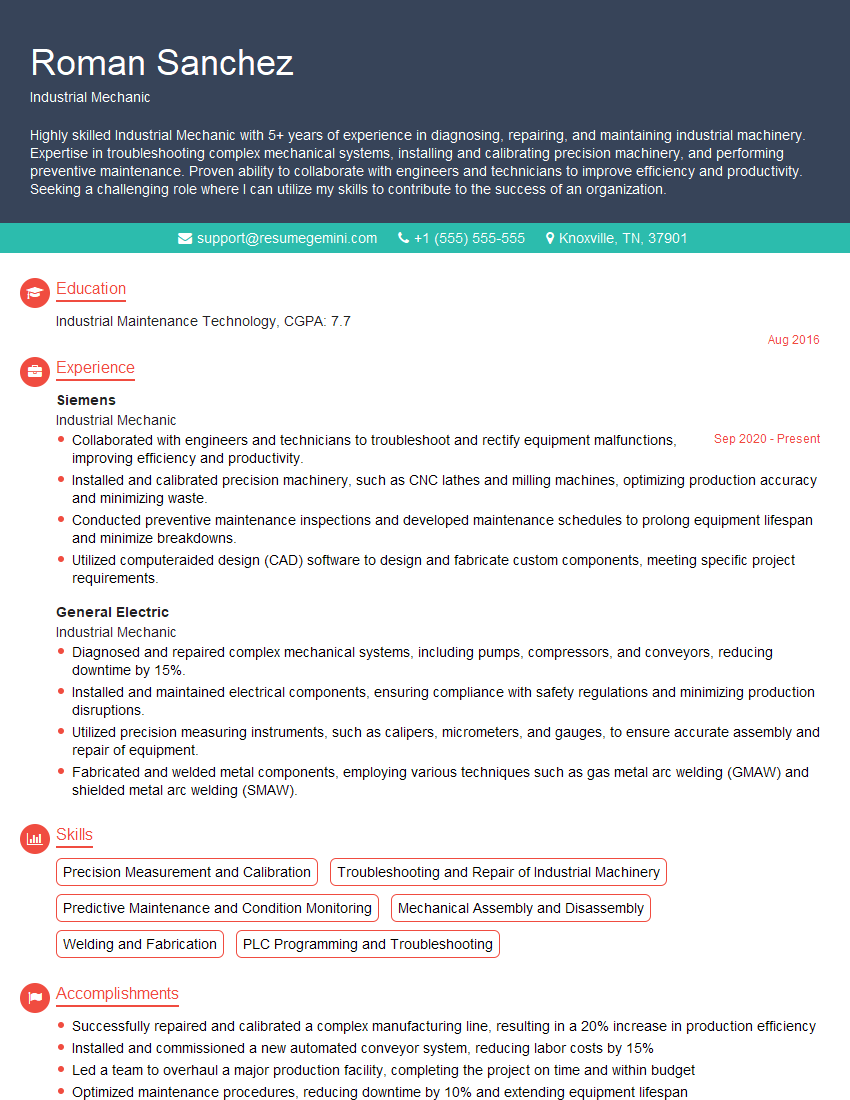The right preparation can turn an interview into an opportunity to showcase your expertise. This guide to Safe handling of tools and equipment interview questions is your ultimate resource, providing key insights and tips to help you ace your responses and stand out as a top candidate.
Questions Asked in Safe handling of tools and equipment Interview
Q 1. Describe your experience with Lockout/Tagout procedures.
Lockout/Tagout (LOTO) procedures are critical safety measures designed to prevent the unexpected energization or startup of machinery and equipment during maintenance or repair. My experience encompasses years of hands-on application and training in LOTO procedures across various industrial settings. I’ve worked with a range of equipment, from simple machinery to complex automated systems. This includes verifying the complete de-energization of equipment, properly applying lockout devices, verifying the effectiveness of the lockout, and the safe removal of lockout devices after completion of work. For example, in my previous role, I was responsible for leading LOTO procedures on a large conveyor belt system. This involved coordinating a team, ensuring each step was followed meticulously according to our company’s established LOTO procedures, and documenting every stage of the process.
The process typically involves identifying all energy sources, isolating them using appropriate lockout devices (like padlocks or safety tags), verifying the isolation by testing, and then tagging the equipment to prevent accidental re-energization. Thorough documentation is crucial, and I always adhere to a strict process for verifying, signing, and dating the lockout tag. Failure to follow proper LOTO procedures can lead to severe injury or even death.
Q 2. Explain the importance of using Personal Protective Equipment (PPE).
Personal Protective Equipment (PPE) is paramount in any workplace where hazards exist. Its importance lies in its ability to act as a barrier between the worker and potential hazards, minimizing the risk of injury or illness. Think of PPE as your first line of defense against workplace dangers. Without it, workers are significantly more vulnerable to accidents and health problems. Proper PPE usage dramatically reduces the likelihood of serious injuries, ultimately leading to a safer and more productive work environment. For example, a simple cut on the hand might become a severe infection without the appropriate gloves. Similarly, hearing loss can be avoided with proper ear protection in a loud environment.
Q 3. What are the different types of PPE and when should each be used?
There are various types of PPE, each designed for specific hazards. These include:
- Eye protection: Safety glasses, goggles, face shields protect against flying debris, chemicals, and intense light. I’ve seen firsthand how critical safety glasses are in preventing eye injuries during grinding or welding.
- Hearing protection: Earplugs or earmuffs protect against excessive noise that can lead to hearing loss. Working in construction without ear protection would be unthinkable due to the constant loud machinery.
- Respiratory protection: Respirators filter out airborne contaminants like dust, fumes, or gases. This is essential in environments with hazardous materials such as asbestos or welding fumes.
- Hand protection: Gloves protect hands from cuts, abrasions, chemicals, and extreme temperatures. Appropriate gloves are chosen depending on the specific task, ranging from basic work gloves to chemical-resistant gloves.
- Head protection: Hard hats protect against falling objects. This is a fundamental piece of PPE in many industries such as construction.
- Foot protection: Safety shoes or boots protect feet from punctures, crushing injuries, and electrical hazards. Steel-toe boots are a staple on construction sites and in industrial settings.
- Body protection: High-visibility clothing, aprons, and coveralls protect against cuts, abrasions, and chemical splashes.
The choice of PPE depends entirely on the specific hazards present in a particular work environment. A thorough risk assessment is always the first step in determining the appropriate PPE to use. No two jobsites or tasks have identical PPE requirements.
Q 4. How do you identify and report unsafe working conditions?
Identifying and reporting unsafe working conditions is a crucial responsibility for every worker. This involves actively observing the work environment for potential hazards and reporting any issues through the established channels – typically a supervisor or safety officer. My approach involves a systematic approach: first, I carefully assess the situation, identifying the specific hazard and the potential consequences; then, I report it immediately, providing as much detail as possible, including location, nature of the hazard, and potential risks. For example, if I noticed a damaged electrical cable, I wouldn’t simply ignore it; I would immediately report it to my supervisor so it could be repaired.
Effective communication is key. A clear and concise report, including photographs or videos if possible, helps ensure the issue gets appropriate attention. Furthermore, I ensure to follow up to confirm the corrective action has been taken. Ignoring unsafe conditions is not only negligent but also puts yourself and others at risk.
Q 5. Describe your experience with hazard identification and risk assessment.
Hazard identification and risk assessment are foundational to a safe work environment. My experience includes conducting comprehensive risk assessments using various methodologies, such as HAZOP (Hazard and Operability Study) and Job Safety Analysis (JSA). I am proficient in identifying potential hazards, analyzing their likelihood and severity, and developing control measures to mitigate the risks. For instance, in a previous role, I conducted a JSA for a complex chemical mixing process, which identified potential hazards like chemical spills, explosions, and exposure to toxic substances. This led to implementing control measures such as improved ventilation, safety showers, and specific personal protective equipment requirements.
This process typically involves a structured approach: identifying potential hazards, evaluating the likelihood and severity of each hazard, determining the level of risk, and implementing controls to reduce the risk to an acceptable level. Documentation is essential, ensuring a clear record of the assessment and the implemented control measures. Regular reviews and updates of the risk assessment are critical as working conditions or processes evolve.
Q 6. Explain the hierarchy of controls for hazard mitigation.
The hierarchy of controls is a framework for prioritizing hazard control measures, starting with the most effective and progressing to less effective measures. It’s about eliminating hazards entirely whenever possible. The order of priority is typically as follows:
- Elimination: Removing the hazard entirely. If a task involves a dangerous chemical, the best solution is to eliminate the need for that chemical entirely.
- Substitution: Replacing the hazard with a less hazardous alternative. For example, substituting a hazardous solvent with a less hazardous one.
- Engineering controls: Implementing engineering solutions to isolate people from the hazard, like installing safety guards on machinery or improving ventilation.
- Administrative controls: Implementing procedural changes, like job rotation, improved training, or work permits, to reduce exposure to the hazard.
- Personal Protective Equipment (PPE): Providing PPE to workers as the last line of defense. While crucial, PPE is considered the least effective method because it protects the worker rather than removing or reducing the hazard itself.
This hierarchy ensures that the most effective measures are implemented first. The goal is always to achieve the highest level of protection possible, while understanding that sometimes a combination of control measures is necessary.
Q 7. What are the proper procedures for lifting heavy objects?
Lifting heavy objects incorrectly can lead to serious back injuries. Proper lifting techniques are essential for preventing such injuries. The key principles involve planning, posture, and technique.
- Plan the lift: Assess the weight and size of the object, check for obstructions, and clear a path. Get help if needed.
- Position yourself: Stand close to the object with your feet shoulder-width apart, one foot slightly ahead of the other for balance.
- Bend your knees, not your waist: Keep your back straight and lift with your legs, not your back. Imagine your legs acting as a powerful crane.
- Keep the object close to your body: This reduces strain on your back.
- Lift smoothly and steadily: Avoid jerky movements.
- Maintain a good posture: Keep your back straight and your head up throughout the lift.
- Lower the object carefully: Bend your knees and lower the object gradually, using your leg muscles to control the movement.
Following these steps can significantly reduce the risk of back injuries, highlighting the importance of proper body mechanics in handling heavy objects. Remember, always seek help if the load is too heavy or awkward to manage safely.
Q 8. How do you ensure the safe operation of power tools?
Safe power tool operation hinges on a multi-faceted approach encompassing thorough training, meticulous preparation, and unwavering adherence to safety protocols. It’s not just about knowing *how* to use a tool, but understanding its limitations and potential hazards.
- Training and Competency: Before operating any power tool, comprehensive training is crucial. This includes understanding the tool’s specific functions, safety features (like guards and emergency stops), and proper techniques for its use. Only operate tools you’ve been properly trained on.
- Pre-Operational Checks: Always inspect the tool before use. Check for damaged cords, loose parts, or worn blades. A quick visual inspection can prevent serious accidents. For example, a damaged cord on a circular saw could lead to electric shock.
- Personal Protective Equipment (PPE): Always wear appropriate PPE, including safety glasses, hearing protection, and work gloves. The type of PPE will vary depending on the tool and the task. For instance, when using a grinder, a face shield is essential to protect against flying debris.
- Work Area Safety: Ensure the work area is well-lit, free of clutter, and provides enough space to operate the tool safely. Avoid distractions and maintain a firm grip on the tool at all times.
- Correct Technique: Use the tool as intended by the manufacturer. Forcing a tool or using it for a purpose it wasn’t designed for can lead to accidents. For example, using a screwdriver as a chisel can cause the tip to break and injure the operator.
- Maintenance: Regularly maintain power tools according to the manufacturer’s instructions. This includes cleaning, lubrication, and replacing worn parts. A well-maintained tool is a safer tool.
Imagine using a table saw without the blade guard – a simple oversight that could lead to a severe hand injury. Following these steps reduces the risk of such accidents dramatically.
Q 9. Describe your experience with machine guarding.
My experience with machine guarding spans several years and various industries. I’ve been involved in the installation, inspection, and maintenance of guarding systems on a wide range of machinery, from woodworking equipment to metal fabrication presses. My focus is always on ensuring that guards meet relevant safety standards and are effectively preventing access to hazardous moving parts.
I’m proficient in identifying and addressing guarding deficiencies. For example, I’ve worked on projects where inadequate guarding allowed access to rotating parts, posing a significant risk of entanglement or amputation. In those cases, we implemented new guards or modified existing ones to fully enclose the hazard. I understand the importance of using the right type of guard for the specific hazard – interlocks, light curtains, or physical barriers – all depending on the situation. Regular inspections are key; I’ve developed checklists and schedules to ensure that guards remain effective and are regularly checked for damage or deterioration.
Furthermore, my experience includes collaborating with engineers and safety officers to design and implement comprehensive guarding programs, ensuring compliance with all relevant regulations and standards. This has included risk assessments, identifying potential hazards, and selecting the most appropriate guarding solutions. A strong focus on worker training and regular inspections is critical for maintaining a safe working environment.
Q 10. What are the safety regulations regarding working at heights?
Safety regulations regarding working at heights prioritize preventing falls, which are a leading cause of serious injury and death in the workplace. These regulations typically mandate the use of appropriate fall protection systems, along with thorough risk assessments and training.
- Fall Protection: This is the cornerstone of height safety, encompassing various systems like harnesses, lifelines, and anchor points. The selection depends on the specific task and environment. For example, a full-body harness with a self-retracting lifeline is suitable for many scenarios, while specialized systems may be required for certain situations.
- Risk Assessment: Before commencing any work at height, a thorough risk assessment is mandatory. This identifies potential hazards and determines the necessary precautions. The assessment should consider factors like the height of the work, the type of surface, and environmental conditions.
- Training and Competency: Workers must receive comprehensive training on the safe use of fall protection equipment and the procedures for working at heights. This training should cover proper harness fitting, rescue procedures, and emergency response.
- Access and Egress: Safe access and egress to and from the work area are crucial. This may involve the use of scaffolding, ladders, or other suitable access equipment, all maintained to the highest safety standards.
- Inspection and Maintenance: Regular inspections of all equipment used for working at heights are essential to ensure its proper functioning and safety. Damaged equipment should be immediately removed from service.
Imagine a scenario where a worker is installing rooftop solar panels without a harness. A simple slip could result in a fatal fall. Adhering to safety regulations prevents such catastrophic outcomes.
Q 11. Explain your understanding of confined space entry procedures.
Confined space entry is inherently dangerous, requiring strict adherence to established procedures to protect workers from asphyxiation, engulfment, or exposure to hazardous substances. These procedures are designed to mitigate risks and ensure the safe entry, work, and exit from confined spaces.
- Permit-to-Work System: A crucial element is a robust permit-to-work system that outlines the hazards, necessary precautions, and emergency procedures. This permit ensures that all necessary checks have been completed before entry is authorized.
- Atmospheric Monitoring: Before entry, the atmosphere within the confined space must be thoroughly tested for oxygen levels, flammable gases, and toxic substances. Continuous monitoring may be required during the work.
- Ventilation: Adequate ventilation is essential to remove hazardous gases and ensure sufficient oxygen levels. This may involve using specialized ventilation equipment.
- Rescue Plan: A comprehensive rescue plan, including designated rescuers and appropriate equipment, is critical. The plan should outline how workers will be rescued in case of an emergency.
- Personal Protective Equipment (PPE): Appropriate PPE, such as respirators, harnesses, and gas detectors, is mandatory for all entrants. The type of PPE will vary depending on the specific hazards present.
- Trained Personnel: Only trained and authorized personnel should enter confined spaces. This training covers hazard awareness, emergency procedures, and the safe use of necessary equipment.
Think of a worker entering a silo without proper atmospheric testing. The lack of oxygen could lead to unconsciousness and death. Following confined space entry procedures is paramount to worker safety.
Q 12. Describe your experience with emergency response procedures.
My experience with emergency response procedures is extensive, involving both theoretical training and practical application in real-world scenarios. I’m proficient in various emergency response protocols, including those for fire, chemical spills, and medical emergencies.
I’ve participated in numerous emergency response drills and simulations, which honed my skills in incident management, evacuation procedures, and first aid. In one instance, I was instrumental in coordinating the safe evacuation of personnel during a fire in a manufacturing facility. My quick thinking and knowledge of emergency protocols minimized disruption and ensured everyone’s safety.
My training encompasses the use of fire extinguishers, emergency communication systems, and other emergency equipment. I understand the importance of clear communication, efficient coordination, and decisive action in emergency situations. Furthermore, I’m familiar with emergency response plans, and I know how to follow these plans accurately and adjust them as circumstances dictate. Maintaining a safe workplace involves understanding emergency response, and participating in frequent drills to ensure preparedness.
Q 13. How do you conduct pre-operational inspections of equipment?
Pre-operational equipment inspections are a crucial step in preventing accidents. They involve a systematic check of the equipment’s condition before it’s put into use. The goal is to identify any potential hazards or malfunctions that could compromise safety.
- Visual Inspection: Start with a thorough visual inspection, checking for any visible damage, wear, or loose parts. Look for cracks, dents, corrosion, or frayed cables. For example, a cracked weld on a lifting device could cause it to fail under load.
- Functional Check: Test the equipment’s functionality to ensure all components operate as expected. This might involve testing switches, controls, and safety mechanisms. Ensure that safety guards are in place and functioning correctly.
- Fluid Levels: For equipment using fluids (like hydraulic systems or engines), check fluid levels and ensure they’re within the recommended range.
- Documentation: Maintain detailed records of all inspections, noting any identified defects or issues. This documentation helps track the equipment’s maintenance history and ensures compliance with regulations.
- Reporting and Correction: Report any identified problems promptly and ensure they’re addressed before the equipment is used. Equipment should only be put into service once any defects have been adequately rectified.
Imagine a forklift with a faulty hydraulic system being used to lift heavy loads. The result could be a catastrophic accident. Pre-operational inspections minimize this risk by proactively identifying and addressing potential problems.
Q 14. What are the signs of equipment malfunction and how should they be addressed?
Recognizing the signs of equipment malfunction is critical for preventing accidents. These signs can vary depending on the type of equipment, but some common indicators include unusual noises, vibrations, leaks, and changes in performance.
- Unusual Noises: Grinding, squealing, or knocking sounds often indicate a problem with bearings, gears, or other moving parts. These noises should never be ignored.
- Excessive Vibrations: Strong vibrations can point to imbalance, wear, or misalignment of rotating components. These vibrations can lead to premature failure and potential hazards.
- Leaks: Leaks of fluids, such as oil, hydraulic fluid, or coolant, can indicate damage to seals or other components and potentially lead to equipment failure.
- Changes in Performance: Noticeable changes in the equipment’s performance, such as reduced power, inconsistent operation, or difficulty in controlling the equipment, are also warning signs.
- Overheating: Excessive heat generation can be a sign of a malfunctioning component and can lead to fire hazards.
- Safety Mechanism Failure: If safety mechanisms like emergency stops or guards fail to function correctly, it’s a serious indication that the equipment should be immediately taken out of service.
Addressing these issues requires immediate action. The equipment should be taken out of service, inspected by a qualified technician, and repaired before it’s put back into use. Failure to do so could lead to serious accidents or injuries. For example, ignoring a leak in a hydraulic system could lead to sudden equipment failure during operation.
Q 15. Explain your understanding of different types of fire extinguishers and their uses.
Fire extinguishers are categorized by the type of fire they’re designed to combat. Understanding these classes is crucial for effective fire suppression. Improper extinguisher use can be ineffective and even dangerous.
- Class A: These extinguishers tackle ordinary combustibles like wood, paper, cloth, and trash. They typically use water or a water-based agent to cool the fire and prevent reignition. Think of them as your everyday fire extinguisher for common household fires.
- Class B: Designed for flammable liquids like grease, gasoline, and oil. These extinguishers use a dry chemical agent or carbon dioxide (CO2) to smother the fire, cutting off its oxygen supply. Never use water on a Class B fire—it will spread the flames.
- Class C: These extinguishers are for electrical fires involving energized electrical equipment. They often use CO2 or dry chemical agents to avoid electrical shock. Always ensure power is disconnected before attempting to extinguish the fire if possible.
- Class D: These extinguishers are specialized for combustible metals like magnesium, titanium, and sodium. They require specialized agents to prevent further reactions. These are less commonly found in general workplaces.
- Class K: These extinguishers are designed for kitchen fires involving cooking oils and greases. They use a special wet chemical agent that saponifies (turns into soap) the burning oil, creating a fire-suppressing layer.
For example, in a kitchen setting, a Class K extinguisher would be essential, while a Class A extinguisher might be suitable for a trash can fire. Always check the extinguisher’s label to confirm its classification before use.
Career Expert Tips:
- Ace those interviews! Prepare effectively by reviewing the Top 50 Most Common Interview Questions on ResumeGemini.
- Navigate your job search with confidence! Explore a wide range of Career Tips on ResumeGemini. Learn about common challenges and recommendations to overcome them.
- Craft the perfect resume! Master the Art of Resume Writing with ResumeGemini’s guide. Showcase your unique qualifications and achievements effectively.
- Don’t miss out on holiday savings! Build your dream resume with ResumeGemini’s ATS optimized templates.
Q 16. How do you handle hazardous materials safely?
Safe handling of hazardous materials involves strict adherence to safety data sheets (SDS) and proper personal protective equipment (PPE). Negligence can result in severe health consequences or environmental damage.
My approach involves:
- Identifying Hazards: Carefully reviewing the SDS for each material to understand its potential health effects, flammability, reactivity, and other hazards.
- Using Appropriate PPE: Selecting and wearing the correct PPE, including gloves, eye protection, respirators, and protective clothing, based on the SDS recommendations.
- Proper Storage: Ensuring materials are stored according to the SDS guidelines, including proper labeling, ventilation, and segregation of incompatible substances. For example, oxidizers should never be stored near flammable materials.
- Controlled Handling: Following established procedures for handling, transferring, and using hazardous materials. This includes using appropriate equipment and minimizing spills.
- Spill Response: Having a plan in place for responding to spills, including the use of appropriate absorbent materials and cleanup procedures. Knowing how to properly neutralize certain spills is critical.
- Waste Disposal: Following appropriate procedures for the disposal of hazardous waste, in compliance with all relevant regulations.
Imagine working with strong acids. I would wear chemical-resistant gloves, eye protection, and a lab coat. I would ensure the acid is stored in a properly labeled container in a well-ventilated area, away from any bases. Any spills would be cleaned up immediately with a designated neutralizing agent, and the waste would be disposed of following specific procedures.
Q 17. What is your experience with incident investigation and reporting?
Incident investigation is a crucial part of safety management. My approach is methodical and aims to prevent future incidents.
My experience includes:
- Immediate Response: Securing the scene, providing first aid if needed, and preventing further injury or damage.
- Data Collection: Gathering information from witnesses, reviewing documentation, taking photographs, and collecting physical evidence.
- Root Cause Analysis: Using techniques like the “5 Whys” to identify the underlying causes of the incident, going beyond superficial explanations.
- Corrective Actions: Developing and implementing corrective actions to prevent similar incidents from occurring, which may include procedural changes, equipment upgrades, or additional training.
- Reporting: Preparing detailed reports documenting the incident, its causes, and the corrective actions taken. This may include reporting to regulatory bodies like OSHA.
For example, I investigated a near-miss incident where a worker almost dropped a heavy object. Through interviews and observation, I found that the worker was rushed and hadn’t used the appropriate lifting technique. We implemented additional training on proper lifting techniques and adjusted work schedules to reduce time pressure.
Q 18. Describe your knowledge of relevant safety regulations (OSHA, etc.).
I have a thorough understanding of relevant safety regulations, primarily OSHA (Occupational Safety and Health Administration) standards. My knowledge encompasses a wide range, including hazard communication, lockout/tagout procedures, personal protective equipment (PPE) requirements, and emergency response plans.
Specific areas of expertise include:
- OSHA’s General Duty Clause: Understanding the employer’s responsibility to provide a workplace free from recognized hazards.
- Hazard Communication Standard (HazCom): Knowing how to access, understand, and utilize Safety Data Sheets (SDS) and proper labeling procedures.
- Lockout/Tagout (LOTO): Proficient in the procedures for controlling hazardous energy sources during maintenance or repair to prevent accidental start-up.
- Personal Protective Equipment (PPE): Experienced in selecting and using the appropriate PPE for various hazards, ensuring compliance with OSHA regulations.
- Emergency Action Plans: Familiar with developing and implementing emergency action plans, including evacuation procedures and response to specific hazards.
For example, I ensure all employees are trained on the proper use of LOTO procedures before working on machinery, and I regularly review and update our emergency action plan to address potential changes in the workplace.
Q 19. Explain your understanding of the importance of regular equipment maintenance.
Regular equipment maintenance is critical for safety and efficiency. Neglecting maintenance can lead to equipment failure, injuries, and production downtime.
The importance stems from:
- Preventing Accidents: Regular inspections and maintenance identify and correct potential hazards before they cause accidents. For instance, worn-out electrical cords or faulty brakes on machinery can be identified and addressed.
- Ensuring Equipment Functionality: Maintenance keeps equipment operating at peak performance, reducing the risk of malfunction. This ensures that safety features remain effective.
- Extending Equipment Lifespan: Proper maintenance prolongs the life of equipment, reducing the need for costly replacements and minimizing disruption to operations.
- Compliance with Regulations: Many industries have regulations requiring regular equipment inspections and maintenance to ensure safety and compliance.
Think of a vehicle – regular oil changes, tire rotations, and brake inspections are essential for safe operation. Similarly, regular inspections and maintenance of industrial equipment are crucial for preventing accidents and ensuring a safe working environment.
Q 20. How do you ensure the safe storage and handling of chemicals?
Safe storage and handling of chemicals requires careful attention to detail to minimize risks. Improper storage can lead to spills, reactions, and environmental contamination.
Key aspects include:
- SDS Review: Thoroughly review the SDS for each chemical to understand its storage requirements, incompatibilities, and handling procedures.
- Designated Storage Areas: Chemicals should be stored in designated areas that are well-ventilated, away from incompatible materials, and protected from extreme temperatures and moisture.
- Proper Labeling: All containers should be clearly labeled with the chemical name, hazards, and any special handling instructions.
- Secondary Containment: Use secondary containment, such as spill trays or pallets, to prevent spills from spreading in case of a leak or breakage.
- Inventory Control: Maintain a detailed inventory of chemicals to track their usage, expiry dates, and ensure proper disposal of outdated materials.
- Spill Response Kit: A readily accessible spill response kit with appropriate absorbents, neutralizers, and personal protective equipment is essential.
For instance, flammable liquids should be stored in a designated storage cabinet, away from ignition sources, with a secondary containment tray underneath. Strong acids and bases should be segregated to prevent accidental mixing and potential reactions.
Q 21. Describe your experience with working in a team to maintain a safe work environment.
Working in a team to maintain a safe work environment requires effective communication, collaboration, and a shared commitment to safety. Individual efforts are amplified by a collaborative approach.
My experience involves:
- Participating in Safety Meetings: Actively participating in regular safety meetings to identify hazards, discuss near misses, and share best practices.
- Safety Audits and Inspections: Collaborating with team members to conduct regular safety audits and inspections to identify potential hazards and ensure compliance with safety regulations.
- Peer Observation and Feedback: Participating in peer observations and providing constructive feedback to help team members improve their safety practices.
- Promoting a Safety Culture: Encouraging a culture of safety by reporting hazards, promoting safe work practices, and supporting team members in maintaining a safe work environment.
- Emergency Response Drills: Participating in emergency response drills to ensure that all team members are prepared to respond effectively in case of an emergency.
In a past project, we established a peer-to-peer safety observation program where team members regularly checked each other’s work practices. This led to a significant reduction in near misses and improved overall safety awareness.
Q 22. How do you handle conflicts regarding safety procedures?
Handling conflicts regarding safety procedures requires a calm and professional approach, prioritizing the safety of everyone involved. My strategy involves a three-step process: Understanding, Communication, and Resolution.
Understanding: First, I actively listen to all perspectives to understand the root cause of the conflict. This might involve a difference in interpretation of a safety rule, a disagreement on the best approach to a task, or even a personality clash. It’s crucial to avoid making assumptions and to gather all the facts before proceeding.
Communication: Once I understand each perspective, I facilitate open and respectful communication between the parties. I encourage everyone to express their concerns without interruption and emphasize the importance of collaboration towards a safe solution. Clear and concise language is paramount, avoiding jargon or accusatory tones.
Resolution: Depending on the nature of the conflict, the resolution might involve clarifying the safety procedure, adjusting the task to mitigate the risk, or implementing additional safety measures. In cases of ongoing disagreement, I would escalate the issue to a supervisor or safety manager, ensuring a fair and consistent resolution that adheres to company policy.
For example, if two workers disagree on the proper use of a particular machine, I would gather both their perspectives, review the machine’s operating manual together, and potentially arrange for a refresher training session to ensure both are proficient and agree on the safest operating procedure.
Q 23. Explain your experience with training others on safe tool and equipment handling.
I have extensive experience training others on safe tool and equipment handling, having conducted numerous training sessions for both new hires and experienced workers. My approach focuses on a blend of theoretical knowledge and practical application, ensuring that trainees develop both understanding and competence.
My training sessions typically include:
- Classroom instruction: Covering safety regulations, proper tool usage, risk assessments, and emergency procedures.
- Hands-on demonstrations: Showcasing the correct techniques for using various tools and equipment.
- Practical exercises: Allowing trainees to practice under supervision, providing immediate feedback and correction.
- Quizzes and assessments: Evaluating the trainees’ understanding and competence.
- Follow-up and reinforcement: Regular check-ins to ensure that the learned practices are being consistently applied on the job.
For instance, when training on the use of power saws, I would demonstrate the correct techniques for blade adjustment, material feed, and safety guard operation, followed by supervised practice sessions to ensure proper technique is mastered and any unsafe tendencies can be identified and corrected. I always emphasize the importance of reporting any incidents, however minor they may seem, to foster a proactive safety culture.
Q 24. How do you stay up-to-date on the latest safety regulations and best practices?
Staying up-to-date on safety regulations and best practices is crucial for maintaining a safe workplace. I utilize several methods to achieve this:
- Regularly reviewing relevant publications: This includes industry journals, government safety bulletins, and professional organization resources.
- Attending industry conferences and workshops: These events offer valuable opportunities to learn about the latest safety innovations and best practices from leading experts.
- Participating in professional development programs: Many organizations offer continuing education courses specifically designed to enhance safety expertise.
- Networking with other safety professionals: Sharing best practices and insights with colleagues expands my knowledge base.
- Monitoring regulatory changes: I actively follow changes in legislation related to workplace safety, ensuring compliance with updated guidelines.
For example, I recently completed a course on updated OSHA regulations for lockout/tagout procedures, enhancing my ability to train and supervise colleagues on the latest safe work practices when working with potentially hazardous machinery. Keeping up-to-date enables me to anticipate potential risks and implement proactive measures to prevent incidents.
Q 25. Describe a time you prevented a workplace accident.
During a particularly busy project, I noticed a coworker using a ladder that was visibly damaged – a rung was cracked. It was a situation that could have easily resulted in a serious fall. I immediately intervened, stopping him from continuing his work.
I explained the potential dangers of using a damaged ladder, highlighting the risk of a fall and the resulting injuries. I then secured a replacement ladder, ensuring it was properly inspected and in safe working condition. This swift action prevented a potentially catastrophic accident. The subsequent discussion with my coworker emphasized the importance of self-inspection of equipment and the reporting mechanism for damaged tools. It also reinforced that we are responsible for our own safety and the safety of our colleagues.
Q 26. How do you handle a situation where a coworker is not following safety procedures?
Addressing a coworker who isn’t following safety procedures requires tact, understanding, and a focus on collaboration. My approach is based on a constructive feedback model:
Approach with empathy: I start by approaching the coworker privately and calmly, understanding they might not be intentionally disregarding safety. Perhaps there’s a misunderstanding or a lack of training.
Explain the concern: Clearly and respectfully articulate my safety concerns, explaining the potential risks and consequences of not following procedures. I might point to specific examples or regulations.
Collaborate on a solution: Together, we brainstorm solutions. This may involve refresher training, adjustments to the work process, or additional safety measures. The aim is to find a mutually agreeable path to safety compliance.
Escalate if necessary: If the behavior continues despite my intervention, I escalate the concern to my supervisor, documenting the incidents and my attempts to address them. Safety is paramount, and it’s crucial to ensure consistent adherence to procedures.
For example, if I observed a coworker not wearing appropriate eye protection while using a grinder, I’d remind them of the importance of eye safety, offer them the necessary protection, and reiterate the company’s safety regulations. If the behavior persisted, I’d report it to my supervisor to ensure appropriate action is taken.
Q 27. Explain your understanding of the importance of a safety culture.
A strong safety culture is fundamental to a productive and injury-free workplace. It’s more than just following rules; it’s a shared belief and commitment to safety at every level of the organization. A positive safety culture is characterized by:
- Open communication: Workers feel comfortable reporting hazards and near misses without fear of retribution.
- Proactive risk management: Hazards are identified and addressed before incidents occur.
- Shared responsibility: Everyone is accountable for their own safety and the safety of others.
- Leadership commitment: Management demonstrates a clear commitment to safety through actions and policies.
- Continuous improvement: Safety processes are constantly reviewed and improved based on feedback and data.
The benefits of a strong safety culture are significant. They include reduced workplace accidents, increased productivity, improved employee morale, and enhanced company reputation. It’s not merely a matter of compliance, but a core value that promotes a culture of respect, responsibility, and mutual care.
Q 28. What are your strategies for promoting safety awareness in the workplace?
Promoting safety awareness requires a multi-faceted approach that combines education, engagement, and reinforcement. My strategies include:
- Regular safety training and toolbox talks: Frequent training sessions and informal discussions reinforce safety procedures and address current risks.
- Safety campaigns and awareness events: Engaging campaigns using posters, videos, and interactive activities raise awareness about specific hazards and best practices.
- Incentivizing safe behaviors: Rewarding employees who consistently demonstrate safe work habits boosts motivation and encourages adherence to safety procedures.
- Conducting regular safety audits and inspections: Identifying hazards and assessing compliance provides a clear picture of the workplace safety status.
- Encouraging feedback and reporting: Creating a safe environment where employees can openly report near misses or hazards fosters a proactive safety culture.
- Utilizing technology: Employing safety apps, tracking systems, or other technologies that enhance safety procedures and provide real-time data can greatly increase awareness and effectiveness.
For example, during a recent safety campaign, we implemented a ‘Spot a Hazard, Win a Prize’ program, which significantly increased employee involvement in hazard identification and reporting. A proactive and engaging approach transforms safety from a set of rules into a shared value across the entire team.
Key Topics to Learn for Safe Handling of Tools and Equipment Interview
- Tool Selection and Inspection: Understanding the appropriate tools for specific tasks, recognizing signs of wear and tear, and knowing when to replace or repair equipment. Practical application: Describing your process for selecting a drill bit for a particular material and checking it for damage before use.
- Personal Protective Equipment (PPE): Identifying and correctly using appropriate PPE such as safety glasses, gloves, hearing protection, and other safety gear relevant to the tools and equipment used. Practical application: Explaining the specific PPE you would wear while operating a chainsaw and why.
- Safe Operating Procedures: Mastering the correct techniques for operating various tools and equipment, including startup, operation, and shutdown procedures. Practical application: Detailing the steps you would take to safely operate a forklift, including pre-operational checks.
- Maintenance and Storage: Understanding proper maintenance routines for tools and equipment, and safe storage practices to prevent damage and accidents. Practical application: Describing how you would maintain a hand saw and store it to prevent rust and injury.
- Hazard Identification and Risk Mitigation: Identifying potential hazards associated with tool and equipment use and implementing strategies to mitigate those risks. Practical application: Explaining how you would address the risk of electric shock when working with power tools.
- Emergency Procedures: Knowing the appropriate response to accidents or emergencies involving tools and equipment, including first aid procedures where applicable. Practical application: Describing your actions if a colleague is injured by a falling object while working on a construction site.
- Lockout/Tagout Procedures: Understanding and applying lockout/tagout procedures to prevent accidental energization of equipment during maintenance or repair. Practical application: Describing the steps involved in safely performing lockout/tagout procedures on a piece of machinery.
Next Steps
Mastering safe handling of tools and equipment is crucial for career advancement in numerous fields, demonstrating your commitment to safety and efficiency. A well-crafted resume is your first impression; make it count! Building an ATS-friendly resume is essential to maximize your job prospects. ResumeGemini is a trusted resource to help you create a professional and effective resume that highlights your skills and experience. Examples of resumes tailored to showcasing expertise in safe handling of tools and equipment are available to guide you.
Explore more articles
Users Rating of Our Blogs
Share Your Experience
We value your feedback! Please rate our content and share your thoughts (optional).
What Readers Say About Our Blog
Dear Sir/Madam,
Do you want to become a vendor/supplier/service provider of Delta Air Lines, Inc.? We are looking for a reliable, innovative and fair partner for 2025/2026 series tender projects, tasks and contracts. Kindly indicate your interest by requesting a pre-qualification questionnaire. With this information, we will analyze whether you meet the minimum requirements to collaborate with us.
Best regards,
Carey Richardson
V.P. – Corporate Audit and Enterprise Risk Management
Delta Air Lines Inc
Group Procurement & Contracts Center
1030 Delta Boulevard,
Atlanta, GA 30354-1989
United States
+1(470) 982-2456

